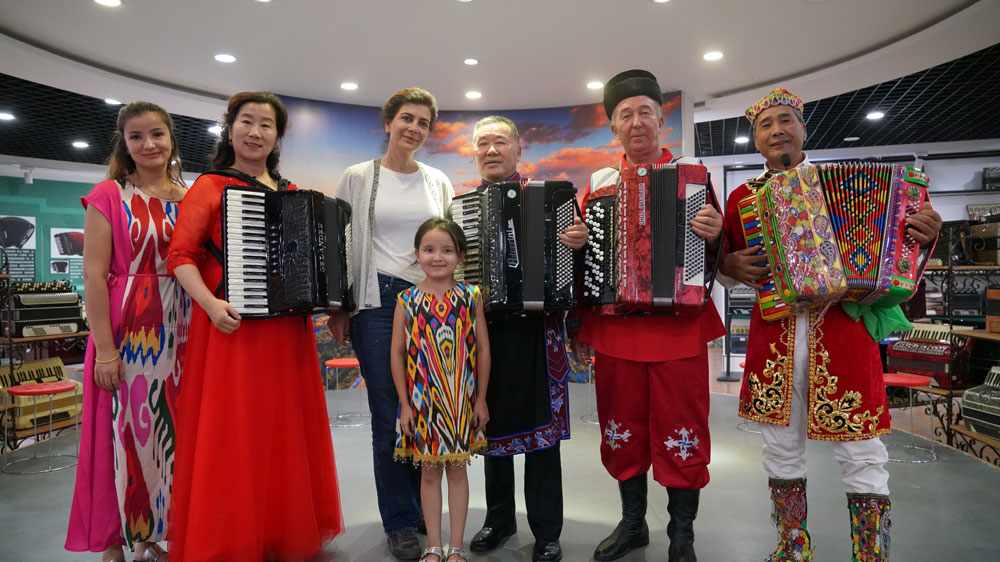

By Asli Atasoy, columnist of Turkish T24

Photo taken on August 9, 2024 shows Asli Atasoy,columnist of Turkish T24, posing for a group photo with performers at an accordion museum on Liuxing Street in Yining City, Ili Kazak Autonomous Prefecture, northwest China's Xinjiang Uygur Autonomous Region. (Photo provided to Guanming Online)
When I received the invitation from Guangming Daily, I knew that writing about China and especially the Xinjiang Uygur Autonomous Region would be difficult. My goal for the trip was to find answers to my questions. Therefore, while traveling in the region, I tried to stray away from the group and communicate with people using the translation app on my phone. When I asked, “Do Uygurs live comfortably here?” the answer I got was always the same: “Yes.” I am aware that I cannot guarantee the accuracy of this answer. I did not go with the intension of making such a claim anyway...
Accompanied by newspaper officials, we toured important cities in the region, primarily Urumqi, as well as Nalati, Horgos, Kuqa and Kashi, for 10 days. While meeting with ethnic groups, we learned about important trade and agricultural organizations and China’s development plan.
Xinjiang, the gateway to the west The region is home to the most ethnic groups in China. Almost half of Xinjiang’s population, approximately 25 million, are Uygurs. The remaining part is home to 56 different ethnic groups, including Han Chinese, Kazakhs, Kyrgyz, Russians, Hui, and Sibe. During my trip as a freelance journalist, I gained many impressions of China and Xinjiang and had the opportunity to chat with people from these different ethnic groups.
China’s longest border With the history of nearly 50,000 years, Xinjiang is China’s gateway to the West via the Silk Road, and borders countries such as Kyrgyzstan, Kazakhstan, Pakistan, Russia and Mongolia. It has always been important in geopolitical terms, just as it is now, and throughout history the Chinese have established their most powerful commands here.
Xinjiang is the largest administrative region in China and its borders account for approximately 1/6 of the country. The world-renowned great mountain ranges, primarily the Tianshan and Altai Mountains, are here. The mountain systems, which hold an important place in the concept of death and life in shamanism, form a fascinating landscape covering millions of square meters of land. Additionally, the second largest desert in the world, Taklamakan, is one of the natural elements that give the region its geographical character.
The region boasts very fertile soil thanks to the continental climate. It ranks on top of the world in fruit production. The cotton produced here accounts for 20% of the world’s textiles. This is why the US called on multinational textile giants not to use Chinese cotton in recent years. On top of that, many minerals and precious stones, especially jade, which is the symbol of Xinjiang, are abundant in the region.
Far away, really far away This is a place where you can understand that distances are relative to where you live. China is such a large geography that all the places described as close are actually very far away. When you drive two hours to a place that is considered very close in the city, it is then easy to understand that the concepts of “close” and “far” are variable. That is why, during our trip, we flew over the fascinating mountain ranges and desert to arrive at the many destinations.
Time in Urumqi The heart of Xinjiang beats in Urumqi. The heart of Urumqi is its symbol, the Grand Bazaar. The Islamic architecture of the bazaar was built with reference to the richness of the Silk Road. Different products are sold in many different buildings in the bazaar. You need to spend hours, maybe even days, to properly visit the stores in the buildings.
Since we had limited time, instead of visiting the shops in the bazaar, we spent time among the people on the very crowded walking path. We saw the importance of Grand Bazaar in the lives of different ethnic groups, especially Uygurs, who gather to chat or make music. They sell their own clothes, and socialize in the bazaar. They sometimes dance to songs, and they sing in their native language.
Yanghang and Id Kah Mosque Yanghang Mosque, an important symbol of Urumqi for the Uygurs, was one of our first stops on the trip. Imam Muhterem Şerif answered our questions at this beautiful, centuries-old mosque, which was also visited by Turkish Foreign Minister Hakan Fidan. Yanghang Mosque stands out as an important meeting point for Uygurs during Friday and Eid prayers.
Our second mosque visit was the Id Kah Mosque in Kashi. This mosque, also visited by Hakan Fidan, dates back to the 15th century and is the largest mosque in Xinjiang. The large pomegranate-motif Hoten carpet hanging on the wall of the mosque was hand-woven in 18 months. The interconnected pomegranate motifs on the carpet represent the 56 ethnic groups living here. For this reason, the carpet is displayed in a special place in the mosque.
Special attention to ethnic groups During the trip, we visited cities and towns where ethnic groups live. We participated in various activities in places where groups such as Kazakh, Kyrgyz, Russian, Sibe, and the Uygurs, live in the vast land of Xinjiang. Places where these groups live densely were chosen for the visit. We had the opportunity to experience the culture of the communities in villages and towns, primarily Uygur. We chatted with many who spoke their native language and wore their local clothes. The ethnic groups here also speak Chinese very well. The traffic signs on the roads are written with both Chinese and Uygur, and the latter is written in Arabic letters.
Those who have not seen Kashi will not understand Xinjiang Kashi has gone down in history as one of the most impressive cities in the world and the most special place we visited. Kashi, one of the starting points of the Silk Road, captivates visitors with the 2000-year-old Kashi Old City in its center. This city, which consists of the world’s oldest known earthen houses, was restored in 2019. Around the center, where 80 percent of the population is Uygur, lie the giant blocks we often see in China. There are hundreds of shops selling souvenirs and handicrafts in this place, with dance shows regularly presented at the entrance where there is a huge influx of visitors. It would not be an exaggeration to say that the bazaar, which is open 24 hours a day, is a fairy-tale city.
“High-quality development” project One of the most striking points of the trip was the International Land Port Area, also located in Urumqi. This center, which connects China to Europe, is described as the new version of the Silk Road. The “high-quality development” project, which Beijing attaches great importance to, is promoted as a guarantee of its claims to be a world trade leader. This project has an important place in the “Belt and Road Initiative”. The facility was built on a huge area to express the grandeur of capitalism. Orders are now delivered to their addresses within days thanks to thousands of trains that are hundreds of meters long. In short, China is rapidly reaching Europe from here with 200 different products in high quality and an ever-increasing trade volume by the day.
Preparing for the food crisis with soilless agriculture During our visit, we visited the high-tech agricultural center in the city of Horgos, one of the measures taken by China against the food crisis. The facility, which is managed by artificial intelligence and uses soilless agriculture, produces 10 times more products than traditional agriculture from tomato seedlings sprouted in coconuts. The taste, color and size of the tomatoes produced in the facility are completely determined by artificial intelligence. It is too early to say whether tomatoes grown with carbon dioxide are harmful to health, but we can say right away that their taste is impressive.
Xinjiang is always different Having been there many times before, I can easily say that you can easily travel around Beijing and Shanghai on your own. The situation is a little different in Xinjiang. Due to previous problems with radical groups, you have to go through strict security checks when entering the region. In addition, although there are impressive tourist attractions in the region, it is very difficult to get out of the city.
Difficult geography, difficult times When I received the invitation from Guangming Daily, I was aware that writing about China and especially the Xinjiang Autonomous Region would be difficult. While making my preparations before the trip, my aim was to find answers to my questions. Therefore, while traveling in the region, I stayed away from the group and tried to communicate with people using the translation app on my phone. When I asked, “Do Uygurs live comfortably here?” the answer I got was always the same: “Yes.” I am aware that I cannot guarantee the accuracy of this answer. I did not go with the intension of making such a claim anyway. However, the claim that “we were paid to write positively of the place” was completely imaginary. A journalist goes to places to reach the truth. This being said, it is the responsibility of the claimants to prove the claims made.
Peace right now! My impression is that there is a different direction in China’s policy, which is aimed at taking precautions against radical structures. I would like to repeat what I said on the last day when they extended the microphone to get our views: “What we all need is a new beginning, and what should be in this beginning is peace!”
点击右上角![]() 微信好友
微信好友
 朋友圈
朋友圈

请使用浏览器分享功能进行分享
